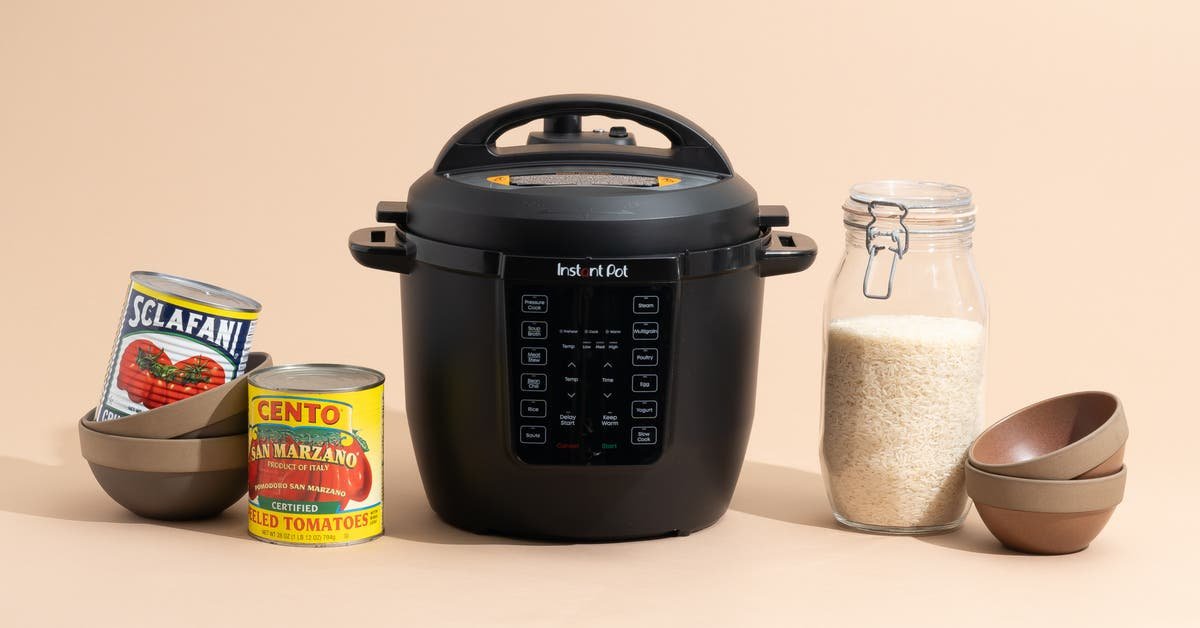
Top pick

The Rio is a versatile time-saver in the kitchen. It’s one of Instant Pot’s more basic and affordable models, and it does everything you need it to do with ease.
The Instant Pot Rio 6-quart, an updated version of our longtime pick, the Instant Pot Duo 6-quart, offers the best performance for its price. It executes basic cooking functions just as well as costlier Instant Pot models, and it does even better than cookers from other brands. The control panel is intuitive, and it’s one of the easier cookers to clean. The durable stainless steel pot will last longer than nonstick inserts, and replacement parts are readily available.

It has a straightforward interface. Despite its many buttons, the Instant Pot Rio (like most Instant Pot models) is simple to use. We were cooking beans within minutes of scanning the instructions.
The Rio now has a start button, which is especially helpful for first-time owners, as well as dedicated temperature and time controls. In contrast, the Duo starts automatically once you set a program, and you have to press the same program button to toggle between temperatures.
A progress bar on the screen lets you know if the Rio is preheating, cooking, or on warm. You can also turn off beeping noises (though safety alerts will still be audible).
The inner pot stays in place. The Rio has four rubber stoppers inside the cooker base, which keep the inner pot from spinning while you sauté or stir. The stoppers don’t prevent movement quite as well as the handles that hold the pot in place on our upgrade pick, the Instant Pot Pro, but the pot stayed still while we sautéed onions and stirred beans. Unless you’re stirring something with a lot of resistance, the rubber stoppers are perfectly effective.
It has three heat levels for precise sautéing. We like that the Rio has three temperature settings for sautéing, whereas some other similarly priced cookers offer only one or two. You can make a sofrito for a soup base using the low-heat setting, for example, or caramelize onions and garlic on the high setting.
It has a range of cooking abilities. The Rio’s programs include presets for making rice, stew, and yogurt, as well as manual programs for sautéing, slow cooking, and pressure cooking, plus a keep-warm setting.
You can also adjust the time within the programmed functions, and the machine will remember that adjustment the next time you turn it on.

The stainless steel inner pot is durable. All of Instant Pot’s electric pressure cookers come with an uncoated stainless steel inner pot that has a tri-ply disk on the bottom to help distribute heat evenly. Most cookers from other brands have nonstick-coated inner pots that don’t brown food as effectively and aren’t as durable.
Even if you’re careful not to scratch the nonstick coating, it will eventually wear out with just a few years of use. A stainless steel pot, on the other hand, will likely outlast the appliance itself.
The steam release is safer. Like all Instant Pot models from 2021 on, the Rio has a steam-release switch that’s easy to use when you want to quickly depressurize the pot. On older Instant Pot models, you needed to turn the valve to release pressure and then quickly pull your hand away from the gush of steam. Now, you can simply slide a switch near the valve. This makes it even safer to use, though you should still keep your hands and face away from the valve. The burst of steam is still forceful and loud, and may be a little jarring for first-time owners.
The lid also automatically seals the steam valve once you lock the lid into place, whereas on older models you had to remember to adjust the valve into the sealed position.

It’s sturdy. Some Wirecutter staffers have owned their Instant Pots for over half a decade, and they say it still works great even after being dropped on the floor or handled by roommates.

The Rio has a one-year warranty, and replacement parts are available online.
The 6-quart Rio is the most useful size for home cooks, but if you’re unsure of what size you need, we break it down here.
Flaws but not dealbreakers
It has some tricky-to-clean spots. Every Instant Pot has some parts that require extra effort to clean. The depression around the rim of the outer pot traps salt, crumbs, and gunk, but we cleared it out with canned air and a damp rag.
Though the lid’s silicone sealing ring can also retain smells, you can deodorize it or buy extras (many people like to use one sealing ring for cooking savory dishes and another for cooking sweet dishes).

It has a lot of buttons. All of the Rio’s programs appear in an array of buttons on the front of the pot, which is a little visually overwhelming (and a bit annoying if you don’t use them). If you’d prefer a more pared-down control panel, we recommend our upgrade pick, which has fewer buttons.
The lid is heavy and can get hot. The Rio’s lid weighs nearly 2.5 pounds, a little more than a quart of milk. The metal finish on the top of the lid will also heat up during cooking, so if you’re concerned about touching it, then we’d recommend the Pro, which has plastic over the lid.
Like all Instant Pot lids, the lid on the Rio has to be twisted to lock in and out of place.
The searing is lackluster. The electric heating element in the Instant Pot can’t sear meat as well as stovetop techniques (an issue with all electric pressure cookers). For intense browning, sear meat in a separate pan on the stove, deglaze, and add the meat and drippings to the electric cooker.
This process may kill your one-pot-dinner fantasies, but sometimes life is a compromise. If you’re looking for more versatility, our upgrade pick’s inner pot is designed to work on most cooktops.
It has only one pressure option. This is the only change to function that we noticed between the Rio and the Duo models. The Duo (and the Pro) offers low- and high-pressure cooking, whereas the Rio offers only high.
But though it’s nice to have an extra option, most pressure cooker recipes are designed for high pressure. Even Wirecutter staffers who use their Instant Pots weekly couldn’t think of a time they’d used low-pressure cooking. Eggs, seafood, and vegetables can all be cooked on high pressure, and in less time, too.





